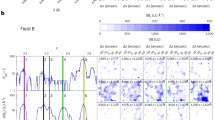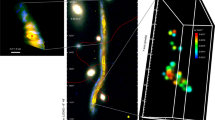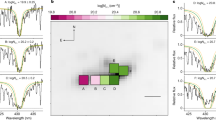Abstract
KNOWLEDGE of the physical state of the relatively uniform component of the intergalactic medium (the 'substrate') is critical to understanding the propagation of ionizing radiation and dynamical energy through intergalactic space, and for establishing the boundary conditions for the formation of the intergalactic gas clouds and galaxies that are assumed to have condensed from it. Uniformly distributed hydrogen, and, even more so, He+ will produce characteristic smooth absorption in the spectra of high-redshift quasars1–4, but at low spectral resolution it is difficult to distinguish such an absorption trough from the cumulative effect of absorption by the Lyman-α 'forest' of clouds. We report the detection of a population of weak 'forest' clouds with column density down to 2 x 1012 cm−2, and show that absorption in these clouds can account for a recent measurement1 of strong He+ absorption without necessarily having to invoke a diffuse intergalactic medium.
This is a preview of subscription content, access via your institution
Access options
Subscribe to this journal
Receive 51 print issues and online access
$199.00 per year
only $3.90 per issue
Buy this article
- Purchase on Springer Link
- Instant access to full article PDF
Prices may be subject to local taxes which are calculated during checkout
Similar content being viewed by others
References
Jakobsen, P. et al. Nature 370, 35–39 (1994).
Gunn, J. E. & Peterson, B. A. Astrophys. J. 142, 1633–1636 (1965).
Jenkins, E. B. & Ostriker, J. P. Astrophys. J. 376, 33–42 (1991).
Webb, J. K., Barcons, X., Carswell, R. F. & Parnell, H. C. Mon. Not. R. astr. Soc. 255, 319–324 (1991).
Madau, P. & Meiksin, A. Astrophys. J. 433, L53–L56 (1994).
Vogt, S. S. et al. S.P.I.E. 2198, 362–375 (1994).
Sargent, W. L. W., Steidel, C. C. & Boksenberg, A. Astrophys. J. Suppl. Ser. 69, 703–761 (1989).
Dobrzycki, A. & Bechtold, J. Astrophys. J. 377, L69–L72 (1991).
Bechtold, J. Astrophys. J. Suppl. Ser. 91, 1–78 (1994).
Cowie, L. L. Songaila, A., Kim, T.-S. & Hu, E. M. Astr. J. (in the press).
Hu, E. M., Kim, T.-S., Cowie, L. L., Songaila, A. & Rauch, M. Astr. J. (submitted).
Miralda-Escudé, J. Mon. Not. R. astr. Soc. 262, 273–276 (1993).
Steidel, C. & Sargent, W. L. W. Astrophys. J. 343, L33–L35 (1989).
Bechtold, J., Weymann, R. J., Lin, Z. & Malkan, M. A. Astrophys. J. 315, 180–197 (1987).
Songaila, A., Cowie, L. L., Hogan, C. J. & Rugers, M. Nature 368, 599–604 (1994).
Petitjean, P., Webb, J. K., Rauch, M., Carswell, R. F. & Lanzetta, K. Mon. Not. R. astr. Soc. 262, 499–505 (1993).
Author information
Authors and Affiliations
Rights and permissions
About this article
Cite this article
Songaila, A., Hu, E. & Cowie, L. A population of very diffuse Lyman-α clouds as the origin of the He+ absorption signal in the intergalactic medium. Nature 375, 124–126 (1995). https://doi.org/10.1038/375124a0
Received:
Accepted:
Issue Date:
DOI: https://doi.org/10.1038/375124a0
Comments
By submitting a comment you agree to abide by our Terms and Community Guidelines. If you find something abusive or that does not comply with our terms or guidelines please flag it as inappropriate.



